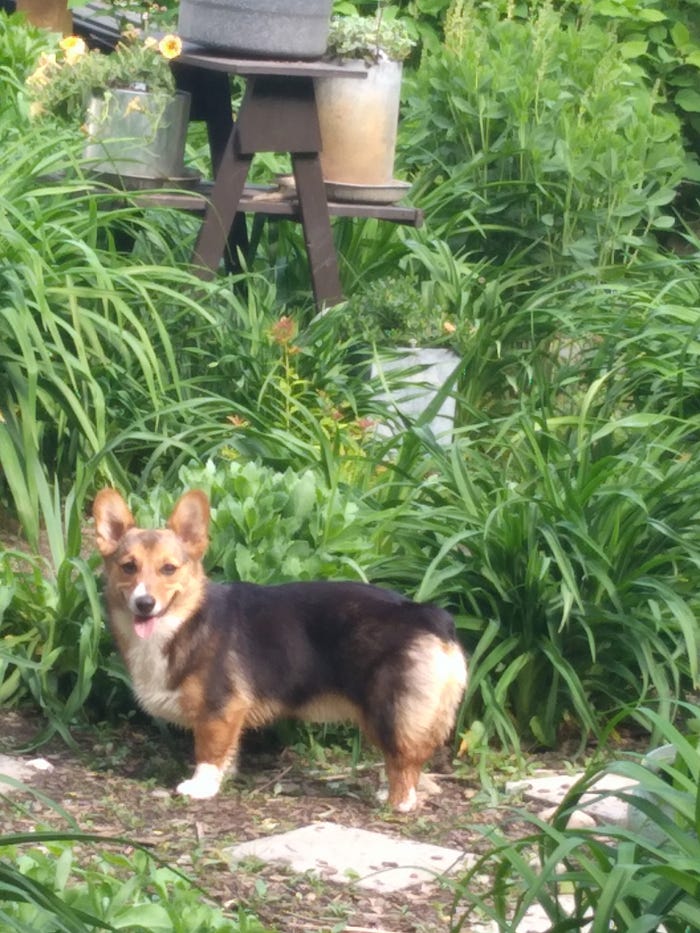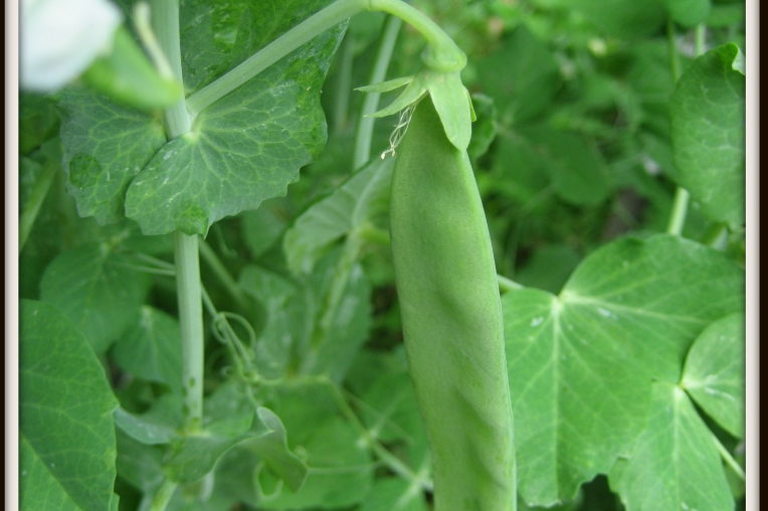Good question. If I asked you to see a vegetable garden in your head, I bet you would see green, crisp heads of lettuce, fat green peas on the vine, round, red tomatoes, yellow corn, orange pumpkins, and zucchini the size of a small baseball bat.
Pretty, isn’t it? This is what I used to see, and man, could I feel my blood pressure go down each time I imagined it.
As I learned, the big problem with what we see here is that what’s growing isn’t going to feed us for very long, or give us a really great return on our investment of money, time, and space. So we need to adjust our thinking, and make substitutions in what we grow so we will get more food out of whatever space we’ve allotted for it.
Instead of fat shelling peas, make a change to snow peas or snap peas. Why? You eat the whole pod. One season of growing shelling peas, where you start with a huge pile of pods and wind up with a small pile of peas and a huge pile of inedible husks, you’ll realize that you’ve spent your time and space for very little. Grow peas where you can eat the WHOLE PEA. More calories, less waste.
Instead of orange pumpkins, make a change to weird, warty, winter squash. The orange pumpkins that we see in stores at Halloween and carve into jack-o-lanterns are watery, stringy, the seeds are often too big and tough to eat, and they do not store well. Winter squash is packed with flesh that’s sweet and often tastes similar. They store for months on end, and they have less water in them so you’ll get more usable food.
Sweet corn seems to be a big thing in America. I think I missed the boat on that one, as I like it, but it’s not an obsession. If you like it, grow some sweet corn, but know you can’t live off of it. It’s too low in calories, and most of what you get from it isn’t digestible by you. It’s really for flavor and vitamins, if anything. The corn you need to think of? Dent corn. It usually isn’t yellow, but it can be dried, and you can make corn meal in a food processor. Concentrated calories in a small package, not a bad deal.
Zucchini. Sometimes I wonder if people grow this just to get the ludicrous amounts of it that they will get, so they can talk about the ludicrous amount of zucchini they grew. Like a badge of honor, or something. Can we be honest about this? Do you like zucchini? As in, to eat it all the time while it’s producing (because freezing it makes it disgustingly slimy, and drying it makes it, well, dry, and then it disintegrates when you rehydrate it in something)? If you like it, grow a couple of plants and call it good-that’s really all you will need. But it’s a space eating monster in the garden, and though it’s nice to have, it’s not going to get you through a lean time. Oh, and don’t let it get to the size of a small baseball bat. Summer squash are much better when smaller.
Round, red tomatoes. This one I fell for, hard. Except I didn’t grow red tomatoes, I grew tomatoes with names like “Mortgage Lifter” and “Purple Cherokee”. They were ugly as sin, and tasted amazing. There is no problem with wanting a good tomato. Grow a few. Know that these tomatoes are mostly water and do not store at all, so you need to eat them as they ripen. If you are looking for a workhorse tomato, that you can turn into a million useful things later on, you need a plum tomato. Less water, more flesh. You can turn them into sauce, salsa, ketchup, bbq sauce, hot sauce, pickles (when green), chutneys, soup, and on and on.

This is an older image of a harvest basket from my garden. The contents of my baskets now are now pretty different.
Lettuce is fun to grow, because it grows SOOO quickly. Know that it won’t grow in summer, because it’s too hot (though there are some types that mind less) and grows in spring and fall best. Also know that it’s very easy to grow too much lettuce and there’s not much you can do with it — eat it or let it rot. You can’t preserve lettuce. So grow some lettuce, but grow more things like Swiss chard or kale. They hold over the summers, you can pick them spring, summer and fall, and you can cook with them, freeze them, or dry them.
We’ve changed that garden quite a bit, haven’t we? On top of these changes, we are going to add a whole bunch of super non- glamorous things like…
· Potatoes. Not much to see, but excellent return for your time and space. Great calorie content and easy to store.
· Onions. Also not much to look at, but super useful, because they are in almost every recipe. They are also really easy to store.
· Garlic. Same reason as onions. Plus the bonus that they are planted when nothing else is, and then you can pretty much ignore them.
· Sweet potatoes. These taste good, have great nutrition, and a nice calorie content. They also don’t seem to mind being grown in buckets, like regular potatoes do, so they can be in your garden without taking up bed space.
· Carrots. Yes, please. You can sneak a planting of carrots in between a number of different crops without bothering anything. They are an excellent base for soups and can be frozen, dried, or stored in a basement in a damp sand box.
· Beans. But pole beans, please, not bush. It took me a long time to convert from one to the other, because I really like haricot vert, which are skinny little beans. (I’m a bean snob.) But it takes many more plants to produce beans when they are bush than it does to grow pole beans, so I’ve changed my thinking.
· Dry beans. Some dry beans will not produce as many beans per plant as others. Black beans, for example, produce far fewer beans per plant than black eyed peas do. No matter which type you try, they are super easy to grow, easy to harvest, easy to store. Can you live off of them? Yes, yes, you can.
· Peppers. They are nice to add to things for flavor, like chili. Hot peppers are awesome to add to tacos and such. Peppers can be frozen, dried, or canned (they are used in quite a number of recipes as well).
· Cabbage. Holy moly, vitamins, Batman. Yeah, this one is a good one. Ferment this into sauerkraut or kimchi, and you’ve got some excellent probiotic action in there too.
· Herbs. Why no one thinks these belong in a vegetable garden, I will never know. If you do not have the space to give a bed over to perennial herbs like thyme, sage, chives, and oregano (and you may have others that are perennial by you), then sneak in some annual herbs like basil, cilantro, parsley, or dill. We deserve to enjoy our food, because we work hard to grow it. Herbs will brighten your dishes and require very little input on your part.
There are other crops that are much less “mainstream” that you should try and see if you like, because they are easy to grow and can provide good calories for you. These are things like:
· Turnips
· Beets
· Rutabaga
· Fava Beans
· Parsnips
To name a few. Not glamorous, by any means, but they will feed you. And what if you like eggplant, or bok choi, or something like that? Grow it. But be realistic about how much of it you can eat fresh, know how you’re going to store it, if it can be stored, and how much food value you are actually getting out of it. Make sure it’s worth it.
Things I haven’t found worth growing?
· Celery. Water hog, bug magnet, never looks like anything in the store. Since I grow it for the flavoring it imparts to soups, I now grow Lovage instead. It’s a perennial herb that tastes exactly like celery. You won’t be putting it on a dip tray, but who cares?
· Artichokes. You baby the damn things, they grow spikes, and you eat the middles. Terrible return on your investment.
· Broccoli and Cauliflower. For some reason, the minute I plant these things, every bug in New York comes and eats them. Planted in spring or fall, I get tiny heads and leaves full of holes (and worms in the heads, too, which is disgusting). Plus they take up valuable bed space for a LONG time. For me, they are a no. It might be different for you.
· Asparagus. It’s a short time only crop, which drives me nuts. You miss picking them when they are exactly ready, and they are woody and gross. Plus they are a perennial, so they can never move from where they are. If you love asparagus, don’t put it in your vegetable garden. Put it in your yard somewhere and leave it there to grow. Just make sure you’re watching the ripening time!
· Fingerling Potatoes. Oh they are lovely. They don’t store worth a damn. I don’t want to talk about how many fingerling potatoes went bad on me one year. It’s…too…painful…
· Kalettes ®. Yeah…don’t bother. Just trust me on that one. Seems like a great idea. It isn’t.
The lists above are just what I have come up with after growing many different things over many different years. I hope my experience might help you to think differently about what to grow. The bottom line is this: anything you grow now is something you no longer have to buy or worry about finding in a food store. Things are not going to get better, no matter what the ads say. Make wiser choices about what you grow, and be mindful of what you will get out of the time you are going to spend on it. My advice is to look at other cultures to see how they eat. American wastefulness is extreme, and the American “diet” is not only harmful, but very narrow in scope. Many other cultures take foods you might not think of and use them beautifully and thriftily. This is how we should all be thinking now, but most haven’t caught on yet. Be one of the first.
Next time we’ll talk about when planting takes place. Yes, a vegetable garden is a 3-season thing, if not 4. Crazy!
See you next time!

Bryn in one of the back gardens. She has nothing to do with the article, but she is cute, so there you go!





